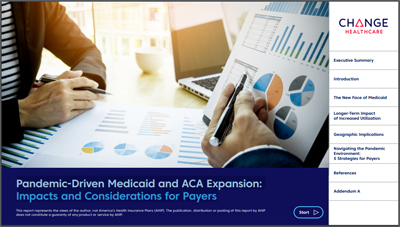Friday
Aug212020
Six Takeaways from a New White Paper for Payers on Pandemic Driven Medicaid and ACA Expansion
by Clive Riddle, August 21, 2020
Change Healthcare has just released a 13-page white paper: Pandemic-Driven Medicaid and ACA Expansion: Impacts and Considerations for Payers, that "details expected changes in the composition of national Medicaid and ACA member populations, and explores the potential financial consequences of the pandemic on payers."

Here are six takeaways from their report:
- Five states with the biggest percentage jump in Medicaid enrollment from Feb 2020 to May 2020: Florida - 9.8%, Missouri - 8.8%, Wisconsin - 8.5%, Minnesota - 8.4%, Kentucky - 8.1%
- Of those with employer-sponsored -care that are losing coverage, nearly half are eligible for Medicaid, and an additional 31% are eligible for marketplace subsidies.
- Expect enrollment backlogs: “Typically, a new Medicaid member is assigned to a Managed Care Organization (MCO) within 45 days after enrolling. Current processing backlogs indicate that window will likely expand significantly and it might be 60 to 90 days before members can receive care through an MCO after enrollment—and that is dependent on the availability of healthcare services.”
- Expect utilization backlogs: ”we expect the most dramatic impact of Medicaid member utilization to hit in 2021, when care services are likely to be more widely accessible.”
- Coverage will shift back: “As the economy rebounds, coverage will likely shift back to commercial lines of business and payers should be prepared for continual changes in coverage for the foreseeable future.”
- Five strategies are recommended payers mitigate challenges caused by the pandemic:
- Prepare your infrastructure by expanding provider networks to increase capacity; expect and plan for payment delays from financially unstable states.
- Collaborate with providers to ensure that members who are most at-risk receive access to necessary healthcare services.
- Accurately identify primary healthcare insurance coverage to reduce exposure and avoid costly recoveries.
- Identify and capture missing risk-adjusting diagnostic codes for members by year’s end, using technology to close risk gaps and validate claims before submission.
- Aggressively manage risk scores by identifying members in need of documentation and proactively facilitating care visits by the end of the calendar year.
 Post a Comment By
Post a Comment By  Riddle, Clive |
Riddle, Clive |  Friday, August 21, 2020 at 10:04AM tagged
Friday, August 21, 2020 at 10:04AM tagged  Innovation|
Innovation|  Reform & Regulatory|
Reform & Regulatory|  Surveys & Reports
Surveys & Reports 

Reader Comments